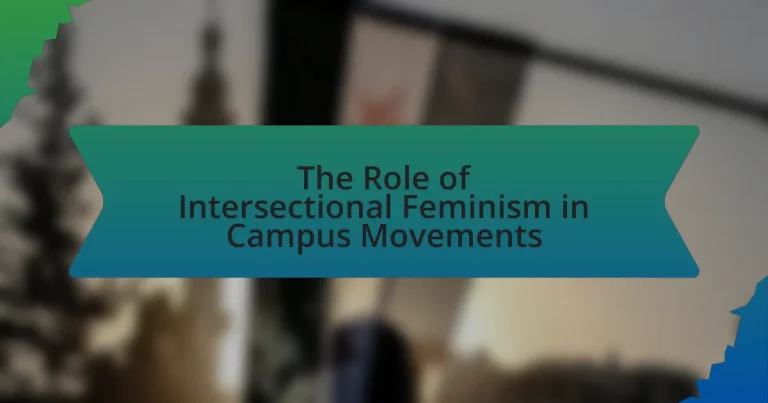Intersectional feminism is a critical framework in campus movements that addresses the diverse experiences and challenges faced by individuals at the intersection of multiple identities, including race, gender, sexuality, and class. This article explores the influence of intersectional feminism on campus activism, highlighting its key principles and the ways it manifests in advocacy efforts. It discusses the importance of inclusivity for diverse student populations, the impact of intersectional feminism on campus policies, and the challenges faced by movements in promoting these principles. Additionally, the article examines strategies for enhancing intersectional feminism in campus activism and its implications for broader social justice issues.
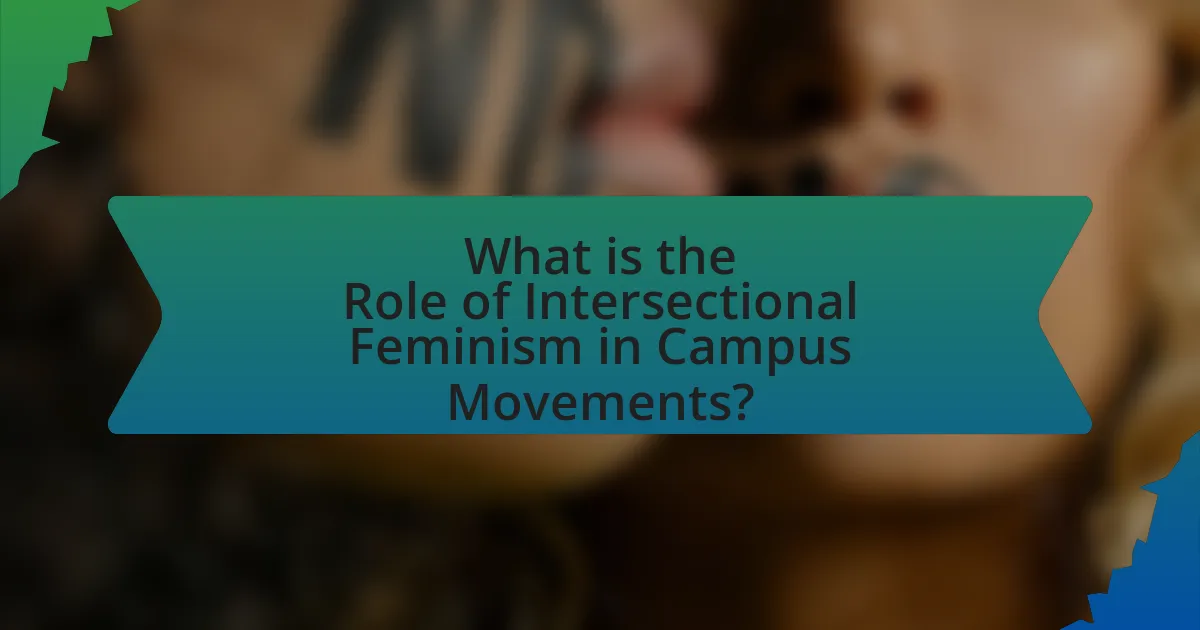
What is the Role of Intersectional Feminism in Campus Movements?
Intersectional feminism plays a crucial role in campus movements by addressing the diverse experiences and challenges faced by individuals at the intersection of multiple identities, such as race, gender, sexuality, and class. This approach fosters inclusivity and ensures that the voices of marginalized groups are represented in advocacy efforts. For instance, research by Crenshaw (1989) highlights how traditional feminist movements often overlook the unique struggles of women of color, emphasizing the need for an intersectional lens to create effective social change. By incorporating intersectional feminism, campus movements can develop more comprehensive strategies that resonate with a broader range of students, ultimately leading to more equitable and just environments on campuses.
How does Intersectional Feminism influence campus activism?
Intersectional feminism significantly influences campus activism by promoting inclusivity and addressing the diverse experiences of marginalized groups. This approach encourages student activists to consider how various identities—such as race, gender, sexuality, and class—intersect and impact individuals’ experiences with oppression. For instance, research from the University of California, Berkeley, highlights that intersectional frameworks lead to more effective advocacy strategies, as they recognize the unique challenges faced by students from different backgrounds. By fostering a more comprehensive understanding of social justice issues, intersectional feminism empowers campus movements to create policies and initiatives that are equitable and representative of all students.
What are the key principles of Intersectional Feminism?
The key principles of Intersectional Feminism include recognizing that individuals experience overlapping systems of oppression based on various social identities such as race, gender, sexuality, and class. This framework emphasizes that feminism must address these intersecting identities to effectively advocate for social justice. For example, Kimberlé Crenshaw, who coined the term “intersectionality,” highlighted how Black women face unique challenges that are not addressed by mainstream feminist movements, which often focus primarily on the experiences of white women. This principle underscores the necessity of inclusive approaches that consider diverse perspectives and experiences in feminist discourse and activism.
How do these principles manifest in campus movements?
Intersectional feminism manifests in campus movements through the promotion of inclusivity and the recognition of diverse identities and experiences. For example, student-led organizations often advocate for policies that address the unique challenges faced by marginalized groups, such as women of color, individuals, and those with disabilities. This is evident in initiatives like the “Black Lives Matter” movement on campuses, which highlights the intersection of race and gender issues, leading to increased awareness and policy changes regarding campus safety and equity. Additionally, intersectional feminist principles are reflected in events and workshops that educate students on the interconnectedness of social justice issues, fostering a more comprehensive understanding of activism.
Why is Intersectional Feminism important for diverse student populations?
Intersectional feminism is important for diverse student populations because it addresses the unique and overlapping identities that shape individual experiences of oppression and privilege. This approach recognizes that students come from various backgrounds, including race, gender, sexuality, and socioeconomic status, which influence their educational experiences and challenges. Research by Crenshaw (1989) highlights that traditional feminist frameworks often overlook these complexities, leading to inadequate support for marginalized groups. By incorporating intersectional perspectives, educational institutions can create more inclusive environments that acknowledge and respond to the specific needs of all students, ultimately fostering equity and social justice on campus.
How does Intersectional Feminism address the needs of marginalized groups?
Intersectional feminism addresses the needs of marginalized groups by recognizing and analyzing the interconnected nature of social categorizations such as race, gender, sexuality, and class, which create overlapping systems of discrimination and disadvantage. This approach allows for a more comprehensive understanding of the unique challenges faced by individuals at these intersections, leading to tailored advocacy and support strategies. For instance, research by Crenshaw (1989) highlights how Black women experience discrimination differently than white women or Black men, emphasizing the necessity of intersectional frameworks in addressing specific injustices. By centering the voices and experiences of those most affected, intersectional feminism fosters inclusivity and ensures that the needs of all marginalized groups are acknowledged and addressed within campus movements.
What impact does Intersectional Feminism have on campus inclusivity?
Intersectional feminism significantly enhances campus inclusivity by addressing the diverse experiences and identities of marginalized groups. This approach recognizes that individuals face multiple, overlapping forms of discrimination based on race, gender, sexuality, and socioeconomic status, which informs policies and practices aimed at creating a more equitable environment. Research indicates that campuses adopting intersectional frameworks report higher levels of student engagement and satisfaction, as they foster a sense of belonging among students from various backgrounds. For instance, a study published in the Journal of College Student Development found that intersectional initiatives led to increased participation in campus activities among underrepresented students, demonstrating the positive correlation between intersectional feminism and inclusivity on college campuses.
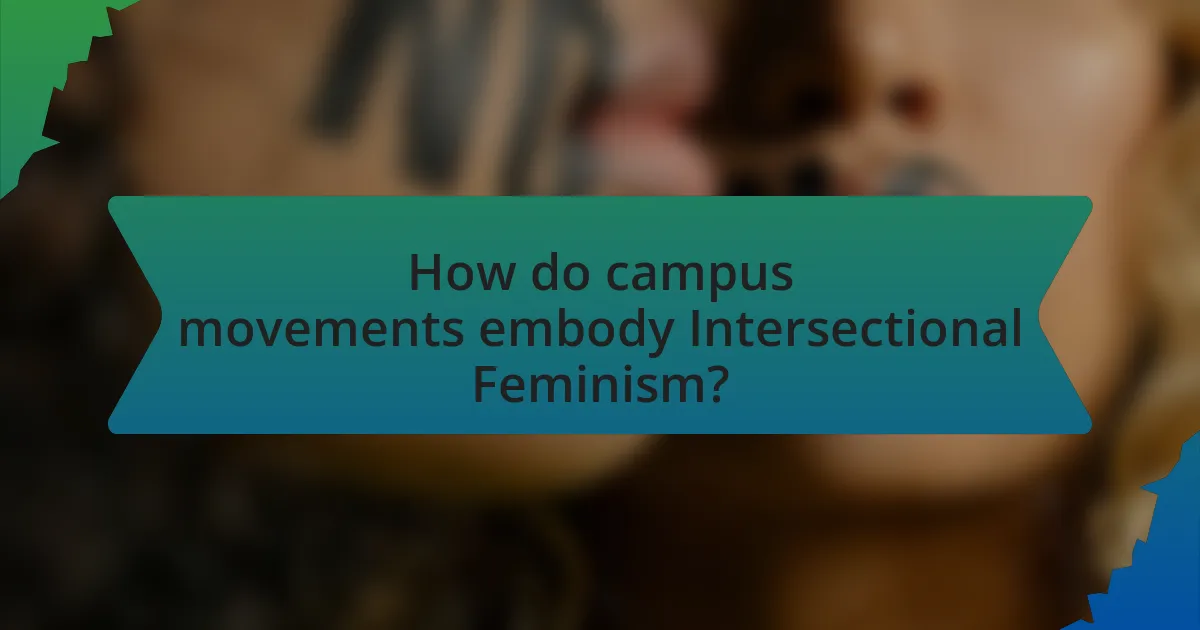
How do campus movements embody Intersectional Feminism?
Campus movements embody Intersectional Feminism by advocating for the rights and experiences of diverse groups, recognizing that gender inequality intersects with race, class, sexuality, and other identities. These movements often focus on issues such as sexual assault, reproductive rights, and racial justice, highlighting how marginalized voices are disproportionately affected by systemic oppression. For example, the #MeToo movement on campuses has not only addressed sexual harassment but has also emphasized the unique challenges faced by women of color and individuals, illustrating the need for an inclusive approach to feminism that considers multiple identities. This intersectional framework is evident in the policies and initiatives proposed by student organizations, which aim to create equitable environments that support all students, regardless of their background.
What are some examples of campus movements that utilize Intersectional Feminism?
Examples of campus movements that utilize Intersectional Feminism include the Black Lives Matter movement on college campuses, which addresses racial injustice while incorporating gender and sexuality issues, and the #MeToo movement, which highlights sexual harassment and assault, emphasizing the experiences of marginalized groups. Additionally, the Women’s March on campuses advocates for women’s rights through an intersectional lens, focusing on issues such as reproductive rights, rights, and racial equality. These movements demonstrate the application of Intersectional Feminism by addressing the interconnectedness of various social identities and injustices.
How have these movements evolved over time?
Intersectional feminism in campus movements has evolved from a focus on gender equality to a more inclusive approach addressing multiple forms of oppression, including race, class, and sexuality. Initially, feminist movements primarily centered on women’s rights, often neglecting the unique challenges faced by women of color and marginalized communities. Over time, activists began to recognize that issues such as systemic racism and economic inequality intersect with gender, leading to a broader understanding of social justice.
This evolution is evidenced by the rise of intersectional frameworks in feminist discourse, particularly after the publication of Kimberlé Crenshaw’s work in the late 1980s, which highlighted the need to consider overlapping identities. Campus movements have increasingly adopted these principles, organizing events and initiatives that reflect diverse voices and experiences. For instance, the #MeToo movement, which gained momentum in the late 2010s, not only addressed sexual harassment but also emphasized the experiences of women from various backgrounds, showcasing the importance of intersectionality in activism.
What strategies do these movements employ to promote Intersectional Feminism?
Campus movements promote Intersectional Feminism through strategies such as coalition-building, inclusive programming, and advocacy for policy changes. Coalition-building involves uniting diverse groups to amplify marginalized voices, ensuring that the experiences of women of color, individuals, and other underrepresented communities are central to the feminist agenda. Inclusive programming includes workshops, discussions, and events that address various intersecting identities, fostering a comprehensive understanding of how different forms of oppression interact. Advocacy for policy changes targets institutional practices that perpetuate inequality, pushing for reforms that reflect the needs of all students, particularly those from marginalized backgrounds. These strategies are effective as they create a more equitable and representative feminist movement on campuses.
How do Intersectional Feminism and campus movements intersect with broader social issues?
Intersectional feminism and campus movements intersect with broader social issues by addressing systemic inequalities that affect marginalized groups. These movements highlight how race, gender, sexuality, and class intersect to create unique experiences of oppression, thereby advocating for social justice across various spheres, including education, healthcare, and labor rights. For instance, the #MeToo movement, which gained traction on college campuses, not only addresses sexual harassment but also emphasizes the experiences of women of color and individuals, showcasing how their struggles are often overlooked in mainstream feminist discourse. This intersectional approach has led to increased awareness and activism around issues such as police violence against Black individuals and reproductive rights, demonstrating the interconnectedness of various social justice movements.
What role does Intersectional Feminism play in addressing systemic inequalities?
Intersectional feminism plays a crucial role in addressing systemic inequalities by recognizing and analyzing how various forms of discrimination—such as race, gender, class, and sexuality—intersect and compound each other. This framework allows for a more comprehensive understanding of social injustices, as it highlights that individuals experience oppression differently based on their unique identities. For instance, a study by Crenshaw (1989) introduced the concept of intersectionality, demonstrating that Black women face distinct challenges that are not fully addressed by traditional feminist or anti-racist movements. By advocating for policies and practices that consider these overlapping identities, intersectional feminism aims to create more inclusive and effective solutions to systemic inequalities.
How do campus movements contribute to national or global feminist discourses?
Campus movements contribute to national and global feminist discourses by amplifying diverse voices and addressing intersectional issues that affect marginalized groups. These movements often serve as incubators for activism, where students engage in discussions and actions that highlight systemic inequalities, such as race, gender, and class. For instance, the #MeToo movement, which gained traction on college campuses, has influenced broader societal conversations about sexual harassment and assault, leading to policy changes and increased awareness. Additionally, campus movements often collaborate with national organizations, thereby linking local issues to global feminist agendas, as seen in initiatives like the Women’s March, which originated from grassroots efforts on campuses. This interconnectedness enhances the visibility of intersectional feminism, promoting a more inclusive dialogue that resonates beyond academic settings.
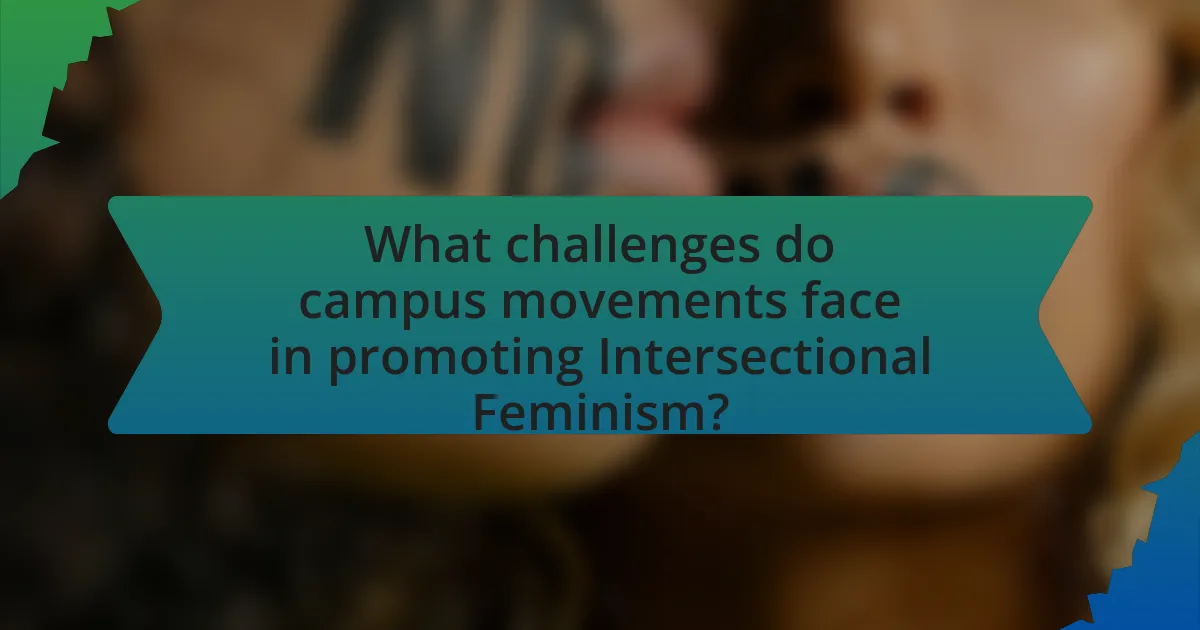
What challenges do campus movements face in promoting Intersectional Feminism?
Campus movements face significant challenges in promoting Intersectional Feminism, primarily due to a lack of understanding and awareness of intersectionality among students and faculty. This misunderstanding often leads to the marginalization of voices that represent diverse identities, such as race, class, and sexuality, which are crucial to the intersectional framework. Additionally, resistance from institutional structures, including administration policies that prioritize mainstream feminist narratives, further complicates efforts to advocate for a more inclusive approach. Research indicates that only 25% of college students are familiar with the concept of intersectionality, highlighting the educational gap that campus movements must address to effectively promote Intersectional Feminism.
What obstacles hinder the effectiveness of Intersectional Feminism on campuses?
Obstacles that hinder the effectiveness of Intersectional Feminism on campuses include a lack of understanding among students and faculty, resistance from institutional structures, and insufficient representation of diverse voices within feminist movements. Many students may not fully grasp the principles of intersectionality, leading to a superficial engagement with feminist issues. Institutional resistance can manifest in policies that do not support inclusive practices or in a lack of resources for intersectional initiatives. Furthermore, when feminist movements on campuses do not adequately represent the experiences of marginalized groups, they risk alienating those very individuals they aim to support, thereby undermining their effectiveness.
How do institutional policies impact these movements?
Institutional policies significantly shape campus movements by either facilitating or hindering their progress. For instance, policies that promote diversity and inclusion can empower intersectional feminist movements by providing resources, support, and a platform for marginalized voices. Conversely, restrictive policies, such as those limiting free speech or student organizing, can stifle these movements and suppress critical discussions on gender and race. Research indicates that campuses with supportive policies see higher engagement in feminist activism, as evidenced by increased participation in events and initiatives aimed at addressing systemic inequalities.
What resistance do activists encounter from within and outside the campus community?
Activists encounter significant resistance from both within and outside the campus community, primarily manifested through institutional pushback and societal backlash. Within the campus, resistance often comes from administration policies that prioritize maintaining the status quo, limiting the scope of activism through bureaucratic hurdles or disciplinary actions against student organizers. For instance, universities may impose restrictions on protests or require permits that complicate mobilization efforts. Outside the campus, activists face societal resistance, including negative media portrayals and opposition from local community members or organizations that disagree with their agendas. This external resistance can manifest in public protests against activist initiatives or campaigns aimed at discrediting their efforts. Such dynamics illustrate the multifaceted challenges activists face in advocating for intersectional feminist issues within campus movements.
How can campus movements overcome these challenges?
Campus movements can overcome challenges by fostering inclusive dialogue and collaboration among diverse groups. By actively engaging various identities and experiences, these movements can address intersectional issues more effectively. Research indicates that intersectional approaches enhance solidarity and understanding, leading to more robust advocacy efforts. For instance, the “Intersectionality in Action” report by Crenshaw (2017) highlights how inclusive strategies in activism can amplify voices and create a united front against systemic inequalities. This collaborative framework enables campus movements to tackle challenges such as marginalization and lack of representation, ultimately strengthening their impact.
What strategies can be implemented to strengthen Intersectional Feminism on campus?
To strengthen Intersectional Feminism on campus, institutions should implement educational programs that promote awareness of diverse identities and experiences. These programs can include workshops, seminars, and courses that focus on the intersections of race, gender, sexuality, and class, fostering a deeper understanding among students. Research indicates that educational interventions can significantly enhance students’ knowledge and attitudes towards social justice issues (Bennett, 2018, Journal of Social Issues). Additionally, creating inclusive spaces for dialogue, such as discussion groups and forums, allows marginalized voices to be heard and valued, further reinforcing the principles of Intersectional Feminism. Engaging in collaborative projects with local community organizations can also provide practical experience and strengthen ties between campus activism and broader social movements.
How can collaboration with other organizations enhance these efforts?
Collaboration with other organizations can significantly enhance intersectional feminism efforts in campus movements by pooling resources, expertise, and networks. When multiple organizations unite, they can amplify their voices, reach a broader audience, and create a more inclusive environment that addresses diverse issues faced by marginalized groups. For instance, partnerships with local advocacy groups can provide specialized knowledge on specific social justice issues, leading to more effective campaigns. Research shows that collaborative initiatives often result in increased participation and engagement, as seen in the 2019 study by the American Association of University Women, which highlighted that joint efforts in advocacy led to a 30% increase in student involvement in feminist initiatives. This demonstrates that collaboration not only strengthens the impact of individual organizations but also fosters a more united front in addressing systemic inequalities on campuses.
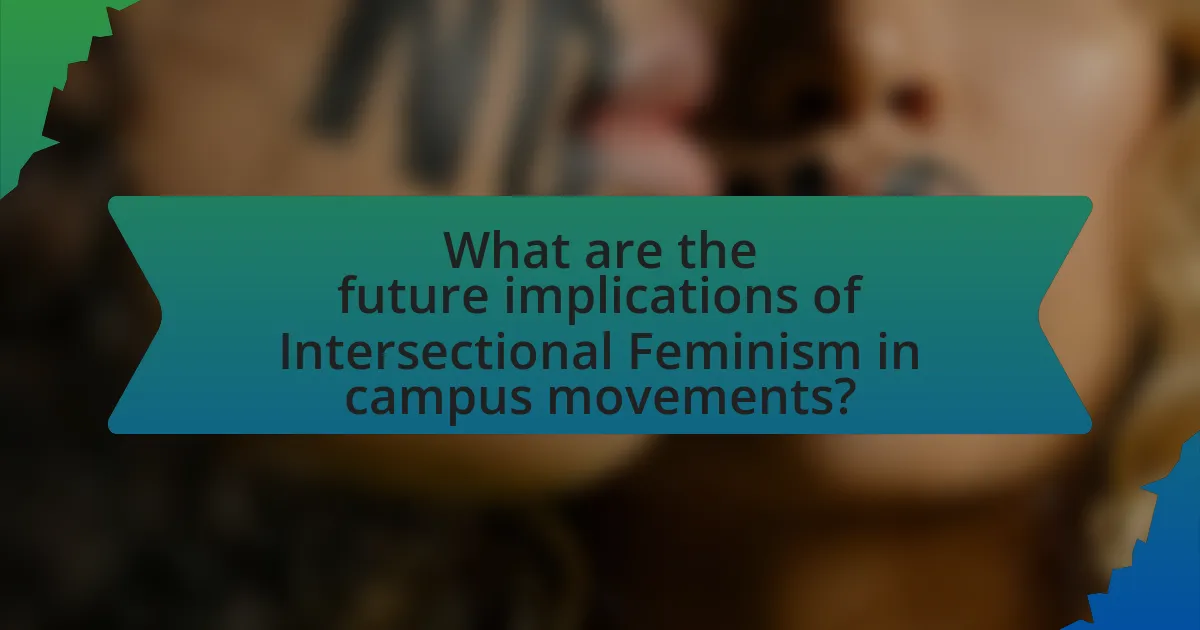
What are the future implications of Intersectional Feminism in campus movements?
The future implications of Intersectional Feminism in campus movements include a more inclusive approach to advocacy that addresses the diverse experiences of marginalized groups. This approach is likely to lead to the development of policies and initiatives that consider race, gender, sexuality, and socioeconomic status, fostering a more equitable campus environment. Research indicates that intersectional frameworks can enhance solidarity among various student groups, as seen in movements like Black Lives Matter on campuses, which emphasize the interconnectedness of social justice issues. By prioritizing intersectionality, campus movements can effectively challenge systemic inequalities and promote comprehensive reforms in areas such as mental health resources, sexual assault policies, and academic support systems.
How might Intersectional Feminism evolve in the context of campus activism?
Intersectional feminism may evolve in campus activism by increasingly addressing the diverse experiences and needs of marginalized groups within educational institutions. As campus movements become more inclusive, they will likely incorporate intersectional frameworks that consider race, gender, sexuality, class, and ability, leading to more comprehensive advocacy efforts. For instance, the rise of coalitions among various student organizations has already demonstrated a shift towards intersectionality, as seen in initiatives like the Black Lives Matter movement on campuses, which emphasizes the interconnectedness of social justice issues. This evolution is supported by research indicating that intersectional approaches can enhance the effectiveness of activism by fostering solidarity and understanding among different groups (Crenshaw, 1989).
What trends are emerging in Intersectional Feminism on campuses?
Emerging trends in Intersectional Feminism on campuses include increased focus on mental health, the integration of diverse voices in leadership roles, and the intersection of climate justice with gender issues. These trends reflect a growing recognition of how various forms of oppression intersect and affect individuals differently. For instance, mental health initiatives are increasingly tailored to address the unique challenges faced by marginalized groups, highlighting the need for inclusive support systems. Additionally, student organizations are prioritizing representation by ensuring that leadership positions reflect a diverse range of identities, which fosters a more inclusive dialogue. Furthermore, the connection between climate justice and gender equality is gaining traction, as activists emphasize that environmental issues disproportionately impact women and marginalized communities. This holistic approach to feminism on campuses is reshaping activism and advocacy, making it more relevant to the complexities of contemporary social issues.
How can students prepare for future challenges in this area?
Students can prepare for future challenges in intersectional feminism on campus by actively engaging in educational workshops and discussions that focus on diverse perspectives within feminist movements. Participation in these activities enhances understanding of the complexities of identity, privilege, and systemic oppression, which are crucial for effective advocacy. Research indicates that students who engage in intersectional training are better equipped to address issues of inequality and discrimination, as highlighted in the study “Intersectionality and Higher Education: Theory, Research, and Practice” by authors K. Crenshaw and M. Collins. This preparation fosters a more inclusive campus environment and empowers students to lead initiatives that address the multifaceted nature of social justice issues.
What practical steps can students take to promote Intersectional Feminism in their movements?
Students can promote Intersectional Feminism in their movements by actively educating themselves and their peers about the diverse experiences of marginalized groups. This can be achieved through organizing workshops, discussions, and reading groups that focus on intersectionality, which recognizes how various forms of discrimination overlap. For instance, a study by Crenshaw (1989) highlights that understanding the intersections of race, gender, and class is crucial for addressing systemic inequalities. Additionally, students can collaborate with local organizations that advocate for marginalized communities, ensuring that their movements are inclusive and representative. By amplifying the voices of those who are often silenced, students can create a more equitable environment on campus.
What resources are available for students interested in Intersectional Feminism?
Students interested in Intersectional Feminism can access a variety of resources, including academic journals, online courses, and community organizations. Academic journals such as “Signs: Journal of Women in Culture and Society” and “Feminist Theory” publish peer-reviewed articles that explore intersectional feminist theories and practices. Online platforms like Coursera and edX offer courses on feminism and social justice, often featuring modules on intersectionality. Additionally, organizations such as the Women’s March and local feminist collectives provide opportunities for activism and community engagement, fostering discussions around intersectional issues. These resources collectively support students in understanding and applying intersectional feminist principles in their studies and activism.
How can students effectively engage their peers in these discussions?
Students can effectively engage their peers in discussions about intersectional feminism by facilitating open dialogues that encourage diverse perspectives. This can be achieved through structured group discussions, workshops, and collaborative projects that focus on real-world applications of intersectional feminist principles. Research indicates that peer-led discussions enhance understanding and retention of complex topics, as seen in studies conducted by the American Educational Research Association, which highlight the benefits of collaborative learning environments in fostering critical thinking and empathy. By creating safe spaces for sharing experiences and viewpoints, students can deepen their collective understanding of intersectional feminism and its relevance to campus movements.
